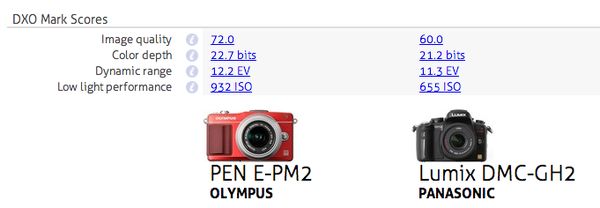4/3 camera
Jan 8, 2014 22:42:27 #
n3eg wrote:
It's a system that's 4/3 than APS-C.
No, seriously, you have full frame (35 mm), APS-C (half the size sensor of full frame) and 4/3 (half the size of APS-C). Bridge cameras and point and shoots are less than 1/6 the size of 4/3.
No, seriously, you have full frame (35 mm), APS-C (half the size sensor of full frame) and 4/3 (half the size of APS-C). Bridge cameras and point and shoots are less than 1/6 the size of 4/3.
4/3 is 50% and an APS-C is 62.5% the size of a full frame sensor. Many p&s sensors are 1/6 the size of FF sensors, not 4/3 sensors.
Jan 8, 2014 22:43:57 #
ocbeyer wrote:
4/3 is 50% and an APS-C is 62.5% the size of a full frame sensor. Many p&s sensors are 1/6 the size of FF sensors, not 4/3 sensors.
Thank you...I knew something wasn't right with that, but I didn't feel like doing the calculations.
Jan 8, 2014 22:44:37 #
joer wrote:
As others have pointed out 4/3 is obsolete replace... (show quote)
4/3 and m4/3 sensors are the same size.
Jan 9, 2014 05:58:26 #
Hi there, I have an Olmpus M4/rd's camera and still cannot understand the term 4/3 rds.
All I know is that M4/3 cameras are a lot smaller and lighter than DSLR's and produce excellent images.
John
All I know is that M4/3 cameras are a lot smaller and lighter than DSLR's and produce excellent images.
John
Jan 9, 2014 06:10:46 #
johneccles wrote:
Hi there, I have an Olmpus M4/rd's camera and still cannot understand the term 4/3 rds.
All I know is that M4/3 cameras are a lot smaller and lighter than DSLR's and produce excellent images.
John
All I know is that M4/3 cameras are a lot smaller and lighter than DSLR's and produce excellent images.
John
4/3 refers to the aspect ratio of the frame a la 8 X 10 or 8.5 X 11. APS-C I believe is 5 X 7, Can make it tricky when cropping and printing to mat and frame. The 4/3 format is culose to modern computer monitor dimensions.
The "m" denotes micro relating to camera size, not sensor size, and is typically (always?) a mirror less interchangeable lens camera with a physical shutter.
Jan 9, 2014 06:29:24 #
lukan
Loc: Chicago, IL
4/3 and m4/3 was initially developed by Olympus as its preferred format for entering into the digital photography world from the film era. Oly/Zuiko created Digital Lenses made specifically for sensor optimization in a digital system as opposed to film, since they discovered that light hit the sensor at an indirect angle causing noise, digital artifacts, etc. Soon after initial research commenced, a collaboration occurred with Panasonic (who joined for lens manufacture with Leica) to fully develop this format. In the meantime, Canon and Nikon were adapting sensors to their DSLR systems and lenses, so that the legacy lens owners (especially all the Canon and Nikon shooting pros) from the film era wouldn't be abandoned. In many ways, 4/3 has provided innovation, quality, color rendition standards, and much more to the Digital photography world. It's still evolving, as is Full Frame sensor (its only real competition), with refinements and improvements happening every product cycle. Today, I wouldn't hesitate (see my sig!) to commit to a top shelf micro 4/3 system and expect wonderful results (which I get), with far less weight and size.
Jan 9, 2014 07:24:52 #
lukan wrote:
4/3 and m4/3 was initially developed by Olympus as... (show quote)
Right. But Olympus 4/3 can utilize all Zuiko and other OM mount glass with infinity focus and with no added glass elements in the lens adapter.
Jan 9, 2014 07:25:37 #
Another thing that is great about the 4x3 aspect ratio is that it is the same ratio as my iPad. No cropping needed :-)
Jan 9, 2014 10:02:19 #
I think the micro 4/3 cameras seem to be weakest when it comes to low light.
Jan 9, 2014 10:12:16 #
RAFriedman wrote:
I think the micro 4/3 cameras seem to be weakest when it comes to low light.
yes and no (depends on the situation)...you just need to know how to handle it...and having fast glass helps.
My capture of the Panstarrs back in march with my EPM2 and 20mm f1.7 It was REALLY dark out...at least 30 minutes after the sun set.

Jan 9, 2014 10:14:44 #
RAFriedman wrote:
I think the micro 4/3 cameras seem to be weakest when it comes to low light.
Depends upon the camera and the processor. The older Olympus E-Series cameras were challenged beginning around 800 ISO. My E-3 compared favorably with my 40D up until 1250-1600 but beyond that it's pretty tough. Why God made flashes, I guess.
But the noise in bright light and at low ISO is often much better than that seen with Canons and Nikons (though honestly I am not sure about the newer models) and there is no touching the Zuiko glass, at least not at other than VERY expensive prices.
That being said the IQ reviews for the EM-1 and EM-5 are pretty outstanding, even by APS-C standards.
Jan 9, 2014 10:16:09 #
Cdouthitt wrote:
yes and no (depends on the situation)...you just need to know how to handle it...and having fast glass helps.
My capture of the Panstarrs back in march with my EPM2 and 20mm f1.7 It was REALLY dark out...at least 30 minutes after the sun set.
My capture of the Panstarrs back in march with my EPM2 and 20mm f1.7 It was REALLY dark out...at least 30 minutes after the sun set.
Great photo. Famous Olympus color.
Jan 9, 2014 10:22:07 #
ocbeyer wrote:
Great photo. Famous Olympus color.
The handling that night when I took the photo is what convinced me that mirrorless was the way to go. The photos that I took with the E-5 after the sun went down were virtually useless.
Now before the sun went down the, the E-5 was great, and I took some cool shots that evening with it. But with no light...the noise was too much to stand...the epm2 stepped in nicely. Funny thing was, I just happened to just grab it on the way out the door...didn't really plan on bringing it with me. Boy that would have been a mistake.
Jan 9, 2014 10:41:07 #
Beautiful shot.
I have a GH2 Lumix and as always I wonder how much the shots' inadequacies are the limitations (not failings) of the camera and how much are my own inadequate technique.
I have a GH2 Lumix and as always I wonder how much the shots' inadequacies are the limitations (not failings) of the camera and how much are my own inadequate technique.
Jan 9, 2014 10:46:28 #
RAFriedman wrote:
Beautiful shot.
I have a GH2 Lumix and as always I wonder how much the shots' inadequacies are the limitations (not failings) of the camera and how much are my own inadequate technique.
I have a GH2 Lumix and as always I wonder how much the shots' inadequacies are the limitations (not failings) of the camera and how much are my own inadequate technique.
This only tells part of the story...I think in 2012, m4/3 sensor technology really took a step forward with the EM5. The epm2 and epl5 pretty much have the same sensor, just way different egonomics and features.
The GH2 sensor was released in 2010. Do you shoot a lot of video?

If you want to reply, then register here. Registration is free and your account is created instantly, so you can post right away.



